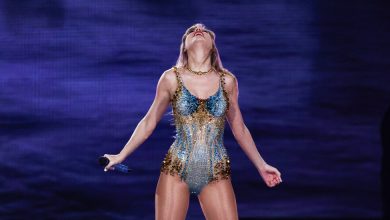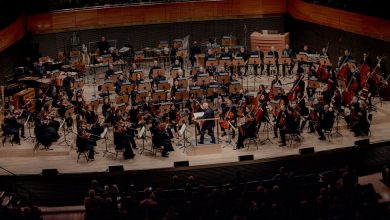Review: In ‘Misdemeanor Dream,’ Speaking to the Unseen

The fairies have stories to share. At least the ones in “Misdemeanor Dream,” who tell tales in English and Native languages, but also via movement and dance, of the births of constellations, the celestial romance that begets all sentient life. But the thicket of music, overlapping dialogue, sounds and projections in this experimental work, presented by La MaMa and the Indigenous feminist theater ensemble Spiderwoman Theater, doesn’t always come together to convey these enchanting stories; in fact, this patchwork often makes the show indecipherable.
At that start of the play, a group of fairies from this realm and other realms emerge from the bowels of a large, multicolored cloth tunnel that leads from backstage to the front. They dance around a red cardboard tree that commands the center of the stage; it seems like an artifact of a mythical world, with multipatterned and brightly colored leaves that hang like shimmering Christmas ornaments. (The set and installation design is by Sherry Guppy, Penny Couchie, Sid Bobb and Mona Damian, in collaboration with Aanmitaagzi, an Indigenous company from Nipissing First Nation in northeastern Ontario, and in partnership with Loose Change Productions.)
The fairies, dressed just as eclectically as the leaves, with red capes, feather boas, blue tutus, pink wings and light-up sneakers (costumes by Damian), go from recounting traditional Native creation myths, sometimes in the original languages of the cast’s nations (including Algonkian, Ilocano and Ojibwe), to personal stories. The ensemble members, who wrote the script together and are directed by Muriel Miguel, comprise 12 Indigenous actors of different ages, performing onstage and via projections. All the while they interrupt each other with fragmented thoughts and exclamations, that is, when the storytellers aren’t being interrupted by sudden blasts of pop music.
This collage-style of storytelling is called “story weaving,” a method that Spiderwoman Theater developed in the 1970s. The technique is just one example of the influence of the company, which has been a pillar of New York’s experimental theater scene for decades. After all, attending a theatrical production whose cast members are of different ages and genders and are from Indigenous nations across the United States, Canada and the Philippines is, unfortunately, a novelty in a predominantly white art form.
However, the story weaving in this production leaves too many loosely tied or unconnected threads, and the heart of the show — accounts of communal traditions and personal experiences — ends up getting lost. This isn’t helped when the performance elements don’t readily cohere around a narrative structure. We aren’t grounded in specific settings, or much acquainted with particular characters; everything is so free-floating that there’s not much to hold onto.
Some more structure would serve the production well in other areas too. The choreography, by Couchie, could be more fluid in its transitions from traditional dancing to the more contemporary, impressionistic gestures. The movement could also better suit the range of ages and abilities of the actors onstage; there are no one-size-fits-all solutions to a show whose performers represent several generations.
The costumes, music and projections similarly seem to function more as pastiche than the means toward illuminating or furthering the story. That would explain the ungainly juxtaposition of, say, a mythic story about a lynx woman and a story about a woman’s love for the actress Julia Roberts, Native round dancing and air guitar, or a reflection on the sounds a decapitated body makes scored to Gene Autry’s performance of “Peter Cottontail.”
The result is a show that undercuts itself, as in one of the final scenes, when Nisgwamala (Gloria Miguel) delivers a monologue that suddenly breaks from the show’s allegorical and abstract style and lands with an explicit plea for us to love each other in our troubled contemporary world. Any resonance the monologue may have is challenged by what comes next: lively pop songs by the Bee Gees and Cher.
The costumes are showy, though if one of the performers could be voted Best Dressed it would be Gloria, Muriel Miguel’s sister and one of the co-founders of Spiderwoman. At a spry 95, she is a dazzling participant, wearing a cosmic star-spangled dress with sleeves adorned with what look like tiny wind chimes hanging from her wrists; every movement of her arms is accented with an airy tinkle and chime.
“Misdemeanor Dream,” which runs a brief 85 minutes, is supposedly inspired by “A Midsummer Night’s Dream,” though the influence of Shakespeare seems to be another thread lost in this story weaving. The work attempts to use a fluid approach to storytelling to reflect stories that have transcendent themes: bodies change, spaces shift and we slip from one realm to the next like one slips from the waking world into the province of dreams. This kind of storytelling, and these Native stories, are essential in theater, but if you’re going to introduce the audience to the reports, fabrications and hearsay of the fairies and spirits of those alternate realms, make sure there’s some tether — even the faintest little thread — to keep us from getting lost in the magic.
Misdemeanor Dream
Through March 27 at La MaMa Experimental Theater Club, Manhattan; lamama.org. Running time: 1 hour 25 minutes.




